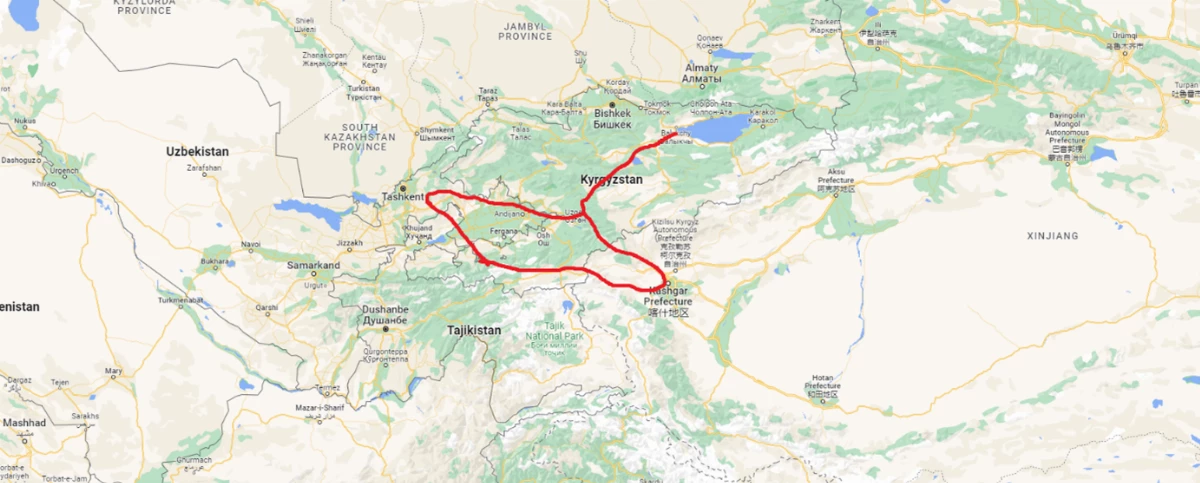
Regional complexities
One of the regional consequences of the development of the Central Corridor in Central Asia is that the previously frozen China-Kyrgyzstan-Uzbekistan railway project has gained new momentum, although Kyrgyzstan does not have the financial resources to cover it with Chinese loans, and its geographical location also makes it difficult to locate the railroad project i phase of implementation.[1]
Middle of 2022, China's National Development and Reform Commission declared that work on the railroad line would resume. This news was confirmed by the project office coordinating the construction of the railroad in early 2023. Although obstacles to the project remain high, the prospects for implementation are more encouraging than at any time since the initiative was announced nearly twenty years ago. If the railroad line is realised, Central Asian countries could expand their trade relations not only with the South Caucasus, but also with Iran.

The complexity of the central trade corridor is illustrated by Beijing's interests. Like the ancient Silk Roads, trade corridors rarely remain static. They constantly adapt to opportunities as they arise and avoid potential geopolitical threats. This is also true of China's Belt and Road Initiative (BRI), which was launched in 2013. As a result, China is particularly interested in the resurgent Middle River, and alternatives to trade routes through Eurasia are critical to Beijing.
Although the South Caucasus does not figure prominently in Beijing's published BRI documents, the Middle Corridor may nonetheless assign an important role to the South Caucasus as the region responds to trade and economic realities with good situational awareness amid evolving geopolitical processes.
The infrastructure of the South Caucasus has already been built (which is beneficial for China). The Baku-Tbilisi-Kars railroad line was opened in late 2017, while the improved network of regional routes from the Caspian Sea to the Black Sea serves as a good starting point for trade relations between China and Unio Ein Europe via the South Caucasus. In addition, Azerbaijan and Georgia have joined the BRI and maintain close trade relations with China.
Conclusions
Russia's war against Ukraine has many significant economic, trade, and geopolitical implications for Central Asia. One of these is the upsurge of developments related to the so-called Central Corridor, which functions as a regional trade integration aimed at creating a rapidly developing land and sea freight route between China and Europe and between the Central Asian and Caucasian regions and Europe, thus providing a viable alternative for the region's economies to diversify Russian-oriented trade relations. The current geopolitical situation suggests that the Central Corridor could benefit Central Asian countries more than the former Northern Corridor, although it is considered a less efficient and costly alternative.
Moreover, Ankara's close cultural ties to the Central Asian republics, as well as their willingness to diversify, but not deteriorate, relations with Moscow (and Beijing), could give Türkey more influence in the region as it expands its foreign policy ambitions to include the Türkic World.
Ironically, with regard to the Central Corridor, some of the European Union's interests coincide with Türkiye's. Ankara and Brussels share an interest in promoting Eurasian connectivity, improving access to trade with the South Caucasus and Central Asia, increasing the flexibility of European supply chains, and diversifying European energy chains. Moreover, from the European perspective, the integration of this type of trade and economic alliance could even lead to the economic and political exclusion of the two regions in Central Asia.
From the perspective of the Central Asian countries, their integration into the economic and commercial life of Europe may serve to balance the egalitarian influence of Russia, China, and Iran (and India).
Several key global players, including China, Russia, and the United States, are positive about the Central Corridor initiative, but uncertainty about the project remains. The key question is whether, alongside more favourable geopolitical and geo-economic conditions and communities of interest, the parties will succeed in making the Central Corridor a fully functional logistics route, or whether it will remain an unsuccessful initiative.
[1] Another delaying factor regarding the China-Kyrgyzstan-Uzbekistan railway project is the somewhat strong nationalistic sentiments in Kyrgyz society towards China.
The author is a researcher at the Eurasia Center